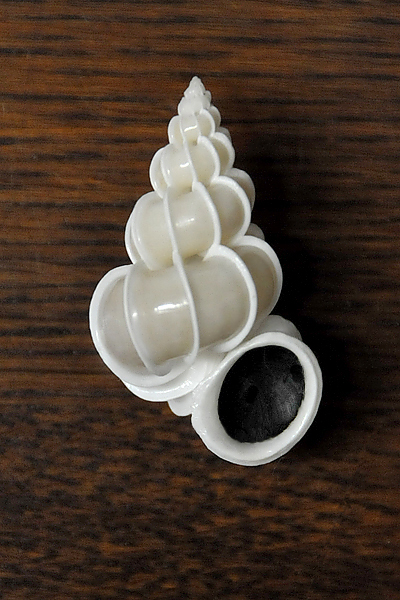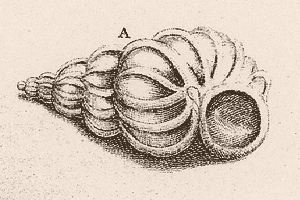
The first published figure of Epitonium scalare ("Precious Wentletrap") appeared in Rumphius' D'Amboinsche Rariteitkamer ("The Ambonese Curiosity Cabinet"), having been added posthumously by the editor "perhaps because his Honor did not encounter them, or perhaps because they do not occur in those regions." He comments that 500 guilders had been refused for a specimen, three of which were then known to exist. One was owned by Cosimo de Medici (to whom Rumphius had been obliged to sell his collection some twenty years earlier) and another by Johan de la Faille, a wealthy burgher from Delft and its chief magistrate. There also was a shell said to be somewhere in England. Half a century later, Linnaeus still considered the Precious Wentletrap to be rare (Systema Naturae, 10th ed. p.713, where it is called Turbinis scalaris). Prior to about 1800, the Dutch controlled access to the shell's habitat but, even by the nineteenth century, when the shell had become more common, it was celebrated for its beauty. (Stories of cleverly fashioned counterfeits made of rice paste would seem to be apocryphal.)
One can understand why. The elegant whorls of the wentletrap do not touch as they coil from spire to aperture but are held in place by a flaring set of ribs (costae). These ribs, which are the margins of its former aperture, mark the growth of the shell and enclose it much like the treads of a spiral staircase. It is from this appearance that its popular and scientific names derive: "wentletrap" from the Middle Dutch wendeltrappe for a winding or spiral staircase, and "scalare" from the Latin scalae for a ladder or flight of stairs.
Lamarck had called the shell Scalaria pretiosa (from the Latin pretiosus, "precious") because of the high price it fetched, as indeed it did. About 1750, the Emperor Francis I, husband of Maria Theresa, paid 4,000 guilders for a specimen, a price that would have a contemporary purchasing power two-to-three-hundred times greater. Three years later, four shells sold in England for more than £75. When the collection of the French ambassador to The Hague was auctioned in 1757, an E. scalare sold for 1,611 livres (for comparison, Diderot was paid 3,500 livres that year to edit his Encyclopédie). Ten years later, a two-inch specimen sold for 900 livres. The Queen of Sweden, the patron of Linnaeus (who utilized her collection in describing many of the shells in his Systema Naturae), owned a wentletrap (and considered it rare, 10th ed., p. 713) as did Catherine the Great (who later purchased Diderot's library and then employed him to care for it) and the Duchess of Portland. At auction in 1786, the Duchess' shell (No. 3933) sold for £7.7s.
Wentletraps feed primarily on sea anemones, from which they draw nourishment through their proboscis. It has been suggested that the purple dye which is released when the mollusk dies is used as an anesthetizing agent in feeding. But this assumption does not seem to be warranted.

This is the first illustration of the Precious Wentletrap, which appeared in the Appendix to Rumphius' D'Amboinsche Rariteitkamer (Plate XLIX). There, its editor described the shell as having "only a nice white color, but its composition is wondrous, and cannot be imagined as such, the way it is in fact." Notice in the etching that the orientation of the shell, like so many prior to the eighteenth century, has been reversed, the dextral shell appearing sinistral.
The pictured shell (top) measures 50 mm or about two inches, which is typical for the species. The dark operculum protects the soft-bodied snail within.
References: Shell Collecting: An Illustrated History (1966) by S. Peter Dance; The Ambonese Curiosity Cabinet: Georgius Eberhardus Rumphius (1999) translated by E. M. Beekman; Rare Shells (1969) by S. Peter Dance; "Wentletraps (Epitoniidae) Feeding on Sea Anemones and Corals" (1963) by Robert Robertson, Journal of Molluscan Studies, 35(23), 51-63; "Neat Nature: The Relationship between Nature and Art in a Dutch Cabinet of Curiosities from the Early Eighteenth Century" (2004) by Bert van de Roemer, History of Science, 42(135), 47-84; "The Value of Money in Eighteenth-Century England: Incomes, Prices, Buying Power—and Some Problems in Cultural Economics" (2015) by Robert D. Hume, Huntington Library Quarterly, 77(4), 373-416; A Catalogue of the Portland Museum, Lately the Property of the Duchess Dowager of Portland, Deceased (April 24, 1786).
See also Rumphius.